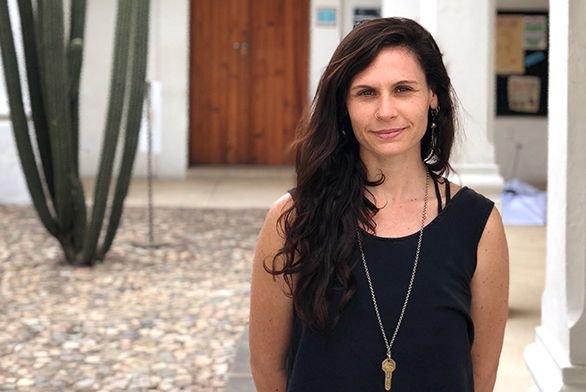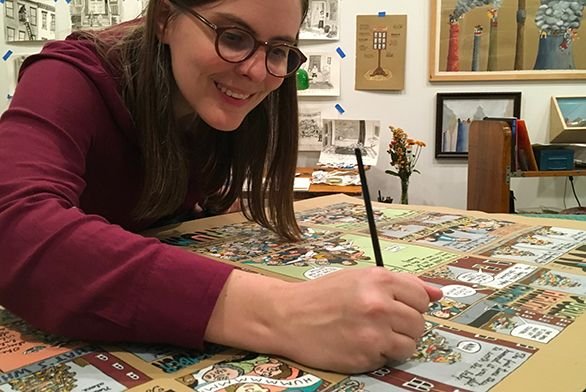Two Alumni Win Coveted Fellowships
August 9, 2018 | By Eve Tolpa

Each year, artists across New York submit their work to the New York Foundation for the Arts (NYFA) and New York State Council on the Arts (NYSA) to compete for the prestigious statewide NYSCA/NYFA Artist Fellowships. The $7,000 award is notoriously difficult to get; of 3,071 applicants, there were only 89 recipients across five genres—and two of them were Johnnies.
Among the 2018 Fellowship recipients were Hannah Jayanti (SF07) of Kings County, honored for her work in video/film, and Caitlin Cass (SF09) from Erie County, for fiction. Unlike many other artist awards, the NYSCA/NYFA Fellowships are given not to support a particular endeavor, but to support the artist in whatever way he or she needs.
“It’s not project-based,” explains Jayanti. “Their whole rationale is that there needs to be some sense of support that is not about a specific thing. This one is just for me.”
Jayanti, who grew up primarily in Southern California, moved to Brooklyn to pursue an MFA in photography, video, and related media from the School of Visual arts. Though she didn’t finish the degree, learning editing helped spark discovery of her calling: documentary filmmaking.
Cass, too, pursued an MFA post-St. John’s, receiving a degree in visual studies from the University of Buffalo. Still, though, she says the mail-order comic book project she started during her graduate school years was “a direct response to reading Program books,” and she went on to publish much of her work under the name “The Great Moments in Western Civilization Cooperative.”
As a comic artist/graphic novelist/“counterfeit” historian, Cass uses her medium to recount notable events in history—with a twist.

“The retellings were loose, more like folktales than factual history,” she says. “They were a way of processing and memorializing my reactions to certain books or historical figures. I was creating my own canon. It was all about the struggle to find a universal truth or system of thought and the impossibility of this task. I have a lot of appreciation for the gallant effort, so the ‘great’ was both serious and sarcastic.”
The fictional pieces she submitted for the NYSCA/NYFA fellowship, titled “The Heap” and “Stretched,” have no direct historical references, however.
Cass says the first “is about a group of people who give up their daily lives to go live in a heap in an empty city lot,” while the second is “about a women who cares so much she winds up paying her abusers for abusing her.”
“These two stories are part of an ongoing series that explores bad habits, hyperbole, and everyday crisis,” she adds.
Mixing fact with fiction is a modality that comes easily to Cass. She has earmarked her NYSCA/NYFA grant for the creation of a small storefront “museum” that charts the rise and fall of Homo sapiens.
“It would focus on how humanity’s weedy gumption often leads to absurd tragedy,” she says. “I have made a few counterfeit history exhibits in the past, so this will be an opportunity to really run with the idea.”
As she says, “I don’t believe anything is entirely objective.”
Unsurprisingly, Jayanti’s work takes on a similarly irresolute tone. Her current project is a feature film with the working title “Truth or Consequences,” which refers to the New Mexico town located not far from a private commercial spaceport that opened in 2011 called Spaceport America.
“In its simplest terms, it’s about the hope and promise of the space project,” she says.
Of course, the simplest terms are never enough for a Johnnie.
“I firmly believe in the multiplicity of experience. Many of my films are trying to show that,” she says. “St. John’s taught me to really actively listen, and documentary filmmaking is active listening in a different way—trying to understand what the other person means, to listen at a lot of levels, both the words and emotions. I feel like I’m obsessed with that idea.”
Jayanti shoots, directs, and edits her own work. She says St. John’s was particularly influential on her editing style, which she calls “associative."
“One of the things I loved at St. John’s so much—one of the highs—was making connections between ideas,” she says. “My brain is very delighted when I am doing that.”
The next generation of artists, too, will benefit from the Johnnie approach. In addition to her drawing and writing work, Cass also teaches art at the Buffalo Seminary, an all-girls independent high school.
“I run my art history classes a lot like a St. John’s class, with opening questions and discussion while looking at slides or looking at original works in local galleries,” she says. “My studio classes are fairly student-directed, but we also do a lot of traditional drawing [and] painting exercises.”
“I think this mix of student agency and tradition is at the heart of the St. John’s Program,” she adds. “Students read traditional books, but they are in charge of interpreting them and deciding what to think about them.”
See more of Cass’ work on her website, caitlincass.com, then go to hannahjayanti.com to see Jayanti’s photography and videography.

